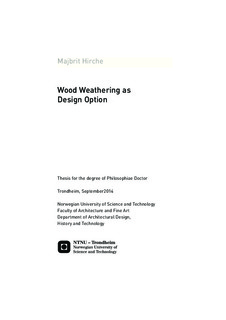| dc.description.abstract | The objective of the presented work is to provide a more thorough understanding of
weathering colors and color patterns of untreated wooden claddings. The perspective
taken throughout this work is that weathering is clearly an option for creating unique
color settings on untreated wooden cladding and that a better knowledge of the color
aspect of weathering will enable and encourage additional creative design in wood
architecture. This approach is in direct contrast to the dominant view in the area of
wood weathering research in which weathering is perceived as a negative consequence
of weather exposure. Chapter 1 introduces the background of this study and specifies
the research objectives. The current state of the research field is discussed in Chapter 2.
Established methods in wood weathering research were of little relevance to this
study. Hence, a preliminary idea-generating exercise on ways to approach the topic was
made. Chapter 3, Section 3.1 discusses the preliminary exercise.
The exercise resulted in four concepts for working with wood weathering:
• Terms for describing weathering of untreated cladding
• The Weathering Equation
• Options for designing an untreated wooden cladding
• Concepts on the relations between cladding design, weather exposure and weathering
colors
The investigation of color development of untreated wooden claddings is based on data
obtained from experiments. The overall idea for the experimental design was to create
a setup that simulated conditions as closely as possible to real life weathering of wooden
cladding in order to generate data with maximum comparability and relevance to
real life situations. The experimental setup was designed to simulate a house with four
vertical, perpendicular façades. A series of 8 different claddings was designed using
untreated, planed, quarter sawn heartwood of Scots Pine (Pinus Sylvestris L.). Each
design was produced in four samples and placed in an above ground vertical position
on walls facing approximately cardinal compass directions at Voll research fields in
Trondheim, Norway. Each sample measured 60x900mm. After 20 months of exposure,
the claddings were disassembled and the surfaces scanned with a flatbed scanner in the
same manner as one would scan a piece of paper. Chapter 3, Sections 3.2 and 3.3 discuss
details of the experimental design, setup and procedures.
The scanned images showed significant variations in the color development of identical
samples that had been exposed to weather from four different directions. Since
wind-driven rain and solar radiation are the main weather factors responsible for color
changes on untreated wooden surfaces, a separate study was undertaken of the distribution
of these weather elements at the Voll research fields. This study is used in Chapter
4 to help understand details of the color development of the claddings. Using data from
an automatic weather station located at the Voll research fields, three types of weather
maps were designed:
• The Directional Weather Map. The map shows the main tendencies in the distribution
of wind-driven rain, UV and sun hours on the horizon.
• The Spherical Weather Map. The map was designed to give an overview of the
mean annual distribution of rain and solar radiation on the hemisphere above Voll.
• The Surface Weather map. The map was designed to visualize the distribution of
wind-driven rain, UV and sun hours on the individual surfaces of the claddings
in the experiment.
The information provided by the weather maps was used to establish the suggestion
of a relationship between the Voll weather and the weathering color development of
the claddings. Chapter 3, Section 3.4 discusses the weather maps. Details in the modeling
and calculation methods are found in Appendix C.
The results documented that the four samples of each cladding type oriented towards
four compass directions at the Voll research fields, developed differences in the weathering
color and color patterns. The differences in color development could be explained
by differences in weather incident on these four compass directions, as demonstrated
by the weather maps. Chapter 4, Section 4.3-4.10 describes the weathering color development of the cladding and analyzes the relationship between cladding design, weather exposure and color development of the wood surfaces.
The results also showed that current guidelines on weathering of untreated wooden
cladding are inadequate for evaluating the potential weather exposure conditions and
the subsequent color development of wooden cladding. A critical hypothesis of this
work is that knowledge of the specific in-situ weather conditions is necessary when
determining the color potentials of any given wooden cladding. The weather maps
designed for this work provide information on the specific in-situ weather conditions.
Chapter 5 discusses the results of this study in relation to current guidelines on weathering
of untreated wooden cladding.
The results obtained in this work point to a number of interesting options for further
development of this field of research in ways that should appeal not just to the architectural
profession but also to the general public, for whom the use of untreated wood
and the ability to predict color outcomes in outdoor applications may be of interest.
Chapter 6 discusses suggestions for future research. | nb_NO |
